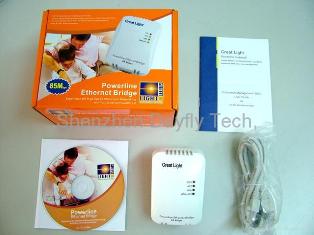Categories: Interesting electrical news, Home automation
Number of views: 67943
Comments on the article: 1
Data transmission over 220 / 380V network
A brief overview of equipment technologies and prices of data transmission devices over 220/380 V. networks
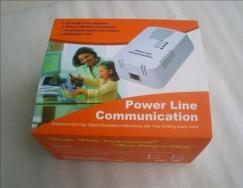 Due to the rapid development of home automation and the increased cost of laying additional communication lines, data transmission between various devices on existing 220-380V lines is of great interest. "From the outlet to the outlet."
Due to the rapid development of home automation and the increased cost of laying additional communication lines, data transmission between various devices on existing 220-380V lines is of great interest. "From the outlet to the outlet."
The control and controlled device or devices are connected by standard network wires to a home electrical outlet and receive power and control signals from it.
So local networks can be built between computers, security and fire alarm networks, smart home systems and similar. The complexity of organizing such networks lies in the fact that this was not initially envisaged, there are no uniform standards, the networks are very noisy, and their parameters change greatly with changing load. When transmitting data over 220 / 380V networks, the high-frequency signal decays quickly. Electromagnetic compatibility and isolation of data transmission from power consumption must be ensured.
The most widely known technologies for transmitting data over 220 / 380V networks are:
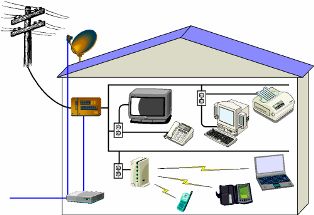
X10 - The oldest technology (1978) is focused on the management of household appliances.
 The main disadvantages are the low speed and low address space, i.e. you remotely turned on the light in your home, and turned on in the neighbor’s one too ... According to this technology, data is transmitted by frequency transmissions (120 kHz) at the moment the AC voltage 220V passes through zero. The binary unit is the presence of a frequency premise, zero is its absence. To increase the noise immunity, repeats, acknowledgment, etc. are introduced. Maximum bit rate 60 bits / s (60 baud). A complete command is transmitted for about 0.8s.
The main disadvantages are the low speed and low address space, i.e. you remotely turned on the light in your home, and turned on in the neighbor’s one too ... According to this technology, data is transmitted by frequency transmissions (120 kHz) at the moment the AC voltage 220V passes through zero. The binary unit is the presence of a frequency premise, zero is its absence. To increase the noise immunity, repeats, acknowledgment, etc. are introduced. Maximum bit rate 60 bits / s (60 baud). A complete command is transmitted for about 0.8s.
The X-10 controllers and terminals are pleasantly pleasing with a low price from $ 8 for a passive receiver, up to $ 100 for a multifunctional active device.
Read more about X10 data transfer technology here: X10 protocol in a “smart” house: should we live on with a veteran?
Intellon CEBus (Intellon SSC) is made by Intellon for the CEBus home network. The CEBus standard (EIA-600) enables the interaction of home automation devices based on various transmission networks: power lines, radio channels, wire channels, etc.
The technology of a noise-like signal is used, which provides for the transmission of each bit of data in the frequency band 100-400 kHz. The transmission speed is at least an order of magnitude higher compared to the X-10. Intellon implements the Power Line Evaluation Kit. Kit for designing and building such a network. Its cost is $ 245.
 Lonworks development by the American corporation Echelon for distributed control networks. The core of the LonWorks technology is the LonTalk protocol for exchanging information. Each network node contains a microprocessor that implements the functions of this protocol.
Lonworks development by the American corporation Echelon for distributed control networks. The core of the LonWorks technology is the LonTalk protocol for exchanging information. Each network node contains a microprocessor that implements the functions of this protocol.
LonTalk is a seven-level communication protocol that enables reliable data transmission through various physical environments. For each type of environment, transceivers have been developed that support network operation at various channel lengths, transmission rates, and network topologies. LonWorks price: $ 42 - for a transceiver, from $ 2000 - for a programming system.
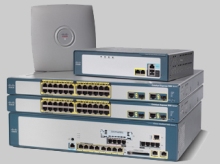 Adaptive networks produces a number of devices that support the transfer of data through any type of wiring. The effective transmission speed is 115 kbit / s. Its distinctive features are exceptional reliability and adaptability (10–9 error probability), noise-like signal, the ability to use twisted pair software, and a very high price.
Adaptive networks produces a number of devices that support the transfer of data through any type of wiring. The effective transmission speed is 115 kbit / s. Its distinctive features are exceptional reliability and adaptability (10–9 error probability), noise-like signal, the ability to use twisted pair software, and a very high price.
DPL 1000, allows you to transfer data over electrical networks at speeds up to 1 Mbps, developed by NOR.WEB. The DPL 1000 is a revolution in power line communications. There are no technical details of the implementation in available sources. In Europe, test connections using DPL 1000 technology are still being tested.If everything goes well, then such a technology is a chance for the Russian Federation to make the Internet fast and accessible for ALL.
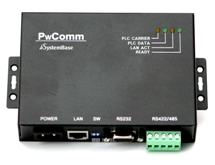 PLC (Power Line Communication), technology for data transmission over 220/380 V, 6/10 kV networks and coaxial networks. A noise-like signal of 1536 subcarriers in the range from 2 to 34 MHz is used. And you can cut out part of the subcarriers if they interfere with other networks. The system itself adapts to noise and power supply. The transmission speed is up to 200 Mbps with a distance between devices up to 300 m. The cost of a subscriber modem is from $ 120.
PLC (Power Line Communication), technology for data transmission over 220/380 V, 6/10 kV networks and coaxial networks. A noise-like signal of 1536 subcarriers in the range from 2 to 34 MHz is used. And you can cut out part of the subcarriers if they interfere with other networks. The system itself adapts to noise and power supply. The transmission speed is up to 200 Mbps with a distance between devices up to 300 m. The cost of a subscriber modem is from $ 120.
For more information on the specified equipment and standards can be found on these sites. Not only commands are transmitted along the wiring lines, but also voice. For example, you can implement a PBX or intercom. The technologies for transmitting information over electric networks have been undeservedly forgotten. As world experience shows, this is a very promising area.
Data transmission over 220 / 380V network
See also at bgv.electricianexp.com
:

